Maracuja Club:
An evidence based, fun and engaging, new way forward.
It's residential and respite, focusing on dementia and nursing care.
Maracuja Club is a complete model, 10 years in development. It's designed to positively transform the experience, lifestyle and outcomes of care for the staff and customers together.
we have the Golden 3:
- An offer of funding
- A system of infrastructure
- A system for social engagement
To unlock the funding we need to partner with an existing care organisation.
Get in touch to explore joining us on the journey to a new, aspirational way of doing care.
Introduction:
Maracuja Club is a first: a clear system for care infrastructure combined with a clear system for social and staff modus operandi.
Systems, especially in healthcare, are key to ensuring repeatable quality outcomes [55]. Maracuja Club is a unique leap forward in this method.
We are making best use of evidence based systems to ensure the highest quality of life and health for staff and customers. Gone are the days of debate and confusion, of one off successes and cycles of burnout.
We know that the behaviour of humans and their quality of life is hugely influenced by two factors:
- The environment/infrastructure in which they live
- & within that context the social and relational systems with which they interact, and that interact with them.
Maracuja Club’s specially designed infrastructure hugely reduces environmental stressors, provides optimally easy access to the proven causes of wellbeing and logically reflects the Maracuja Club system of social activity. Consequently, daily life for staff and customers is made easy and rewarding. The built infrastructure of Maracuja Club is the instrument through which staff burdens are reduced and positively healthy, life affirming, daily living is made spontaneous and simple to achieve.
Maracuja Club’s special system for social activity and care means that, at each moment of each day, at each location within the building, staff are able to positively identify their role and how best to behave in order to maximize the wellness, confidence and mood of our customers.
Staff, supported and reminded by the special infrastructure surrounding them, having been trained in an interactive system of behaviours and methods, are able to provide social experiences that they know will automatically result in enhanced quality of life and long term wellness.
There are massively beneficial psychological and physical health outcomes when stress is reduced, when access to the proven causes of wellbeing is made easy, when mood is enhanced, and when a social methodology for boosting confidence, inclusivity and long term wellness is in place.
When we do all this within an infrastructure designed to make the system for social support easy, staff can fall in love with their work, avoid burnout and enjoy the sense of reward that comes with high quality care giving.
How we got here, in brief:
Maracuja Club takes the very best from concrete acclaimed examples around the world to create a single, clear, transformative vision for care infrastructure and social engagement.
From all the many initiatives studied, five were remarkable. Four of these were witnessed by William McMorran, Maracuja Club, Chief Design Officer, while travelling abroad, sponsored by the Churchill Fellowship [10]. In conversation with Mike Rungie, the then CEO of ACH Group, based in Adelaide, we learnt how the the ViTA restorative care project is a remarkable collaboration between the local Social Care provider, Hospital Care provider, and University. It demonstrates how small communities share high quality living spaces. It combines this infrastructure with a social system that effectively promotes re-enablement with a positive sense of identity. The project is designed to support older people out of crisis and sick role to optimal independent living and regained positive social standing.
At Hammond Care’s Woy Woy dementia specialist home north of Sydney we were able to study how small clusters of residents could live together in a simple household model. Residents' bedrooms remain arranged along a corridor which, although short, had to be navigated before entering the main living space. The focal point is the kitchen work top. Staff understood how the social model is based upon mealtimes and a fairly quiet lifestyle. Here is a clear system for the social support combined with a system for infrastructure that matched it. Their staff easily appreciated this and consequently are happy employees whose turnover was reported as being extremely low.
Two other exemplars of a clear social model for activity, providing richly engaging daily experiences, are the Dotsa Bitove Wellness Academy (Toronto, Canada) and Rose-Mary Droes’ meeting centres model - specifically the King Arthur Groep example in Soest. These two very similar systems are conducted within a semi open plan infrastructure that fully supports the strong (productive-activity centred) social system in place. The proven results for people living with dementia, and other issues, is prevented and reduced development of challenging behaviours and increased retention of ability. Reduced signs and symptoms of dementia are so substantial that, combined with many more beneficial effects, nursing home admission can be delayed by an average of 50%.
Here in the UK, Rose Lodge in Exmouth has also been an inspiration. A strong ethic of living an active and busy lifestyle is combined, where possible, with residents’ rooms opening directly onto activity spaces. The focus is away from the bedroom and firmly on social and engaging things to do. They have been rated outstanding for over 7 years by the CQC and report having virtually no covid deaths and an extremely high staff retention rate.
In summary, the underlying principles are effective:
- a system of infrastructure that maximises access to engaging activity and the causes of wellbeing
- combined with a clear system for social engagement.
The results are manifestly substantial physical and mental health benefits for all participants, also resulting in considerable staff retention advantages.
We set out to further underpin these two key principles with directives drawn from leading scientists and research papers.
Professor Rose-Mary Droes’ work confirms the key importance of a bio-psycho-social - complex systems approach. In simpler language: to achieve the outstanding results in enhanced health and wellbeing we need to do many things at the same time. We need to ensure we simultaneously account for the biological state, the psychological state and the social conditions.
Professor Ute Leonards’ cutting edge work in neuro-psychology combines with other research on the human senses. It guides us to account for the intricacy of human perception. It turns out that much of what is done in the name of fashion and aesthetics can accidentally lead to stress, falls and absorb attention. At Maracuja Club we want cognitive capability to be freed up for better retention of ability; enabling optimal participation in beneficial activity. This is key in care - especially when cognitive function may already be limited due to disease, pain or otherwise coping with other pathologies and substantial life events. To enhance ability we must understated and reduce the, often subtle, causes of stress and disorientation. Maracuja Club creates infrastructure that supports rather than disturbs the senses and thereby maximises retention of ability, energy and positive mood.
Research into positive psychology, mood states, the causes of wellbeing, cognitive bias, flow theory, sense of safety and relationship theory, all combines to result in simple directives for staff. This creates an agreed set of social system guidelines. Think of it as a workshop, over time staff become skilled in choosing and using the tools to fashion engaging and social experiences each day. These result in real, measurable (always clearly visible) positive health outcomes that are part of a great quality of daily life.
We were fortunate to be able to run a small pilot model, in a day respite setting, to trial our nascent evidence based approach to a system for social support.
We designed the job description and social structure and selected and trained the staff in the special system we were developing. Customers paid for the service, which ran for the length of the trial period, for a little over 6 months. The project resulted in some truly outstanding outcomes for participants, who were living with a dementia and/or symptoms of depression, loneliness, stroke and some more complex issues. We were given the 2018 ‘Exceptional Contribution to Dementia Care Award’ at UK Dementia, Care and Nursing Homes Expo for our work up to that point. Subsequently we were approached by researchers from Japan keen to exchange learning with us.
Our experience with the pilot model and the attention it brought us sparked the interest of an NHS Hospital Foundation Trust Chairman. He and a business expert colleague supported us to lay the foundations for the complete residential nursing and respite care project. This was the beginning of 'Maracuja Club', the dementia and nursing home startup.
On route we have received much support and enthusiasm from wide ranging industry leaders, some of whom have joined us as board members and advisers. The project is already proving itself highly attractive to experts within the care world who see the imperative need to do care in new, evidence based, ways and create badly needed alternatives to the struggling long established care system.
Feedback from clinical leads with backgrounds in Nursing and Hospice Care:
“sounds really exciting, sounds like the future and the way care needs to evolve”
“a great model that feeds into a lot of different things”
"people should be breaking your arm off to partner with you on this"
There is also considerable excitement, in these discussions, about other sectors of care that Maracuja Club would work well for, beyond dementia and nursing.
Maracuja Club is strongly backed, and advised, by people living with dementia, who will be shareholders.
We have feedback from participants in the pilot project -
“where are my bags, I want to stay the night”
“these are some of the best days of my life!”
We have received the positive views of Young Dementia Herefordshire -
“How soon can you build it? When can we book a room?”
People want this new alternative system; both care professionals and people in need of support.
We are entering a new phase in care where everyone has much higher expectations - sky high compared to the way they were a generation or two ago.
To a large degree, life experience dictates expectations of care experience. By rising to meet these we can benefit not just the customer, but also the staff, the whole culture of the industry, and ourselves.
“HOW SOON CAN YOU BUILD IT? WHEN CAN WE BOOK A ROOM?"
Let’s make Maracuja Club happen.
To unlock the funding offered, for a special new type of 66 bed dementia, nursing and respite community, the project must become a joint-venture with an existing care organisation.
Let's do it together, contact me directly - roland@maracujaclub.com
Introduction:
Social, physical and environmental evidence is practically applied to the modus operandi of staff and the built environment. The result is an entire transformation in the everyday experience of care, leading to a multitude of resultant benefits.
At Maracuja Club staff become the cutting edge of best practice in actions, words and use of resources derived from the evidence-based model. They are offered a logical framework to guide their actions. They become proud to take on this new creative central role. Suddenly staff can share and hone real recognizable skills. They become the expert in using the science to generate the best possible health and wellness outcomes in the people they support.
Maracuja Club also seeks to enhance the conditions in which staff and customers live by hugely advancing the design quality of the built environment. The unique arrangement of spaces maximises inclusive access to the proven assets of wellbeing and positive cognition while, at the same time, minimising known stressors and abstractions.
At Maracuja Club we do not believe in a clinical approach to what it means and is to be human. Nor do we believe in applied therapies; these impose a particular view about being human and seek to wield control over what we all, by our very nature, already own.
Maracuja Club is about sharing the known evidence and facts that drive the very best of human health. We seek to share these facts in a simple way, so that staff can practice them and enjoy discussing them between each other and those that they support. Ultimately it is the staff who will find the optimum ways of naturally introducing them into the everyday care setting; that works for both them and the people they work with.
Care is inherently a creative act, and although academic schooling would seek to make us doubt it, human beings are inherently creative. It is this that excites me most about the way forward for care that Maracuja Club proposes. We will release the joy, ability and pride of the care workforce, that has always been there, waiting.
‘Fundamental Attribution Error’ [1] is an all too human bias that makes us believe behaviours are inherent. We must challenge this viewpoint if care is to be transformed. We must acknowledge and take seriously that the majority of behaviours, if not all, are caused.
With the right social and built environment, fundamentally derived from the proven causes of wellbeing and with needless stressors removed, the entire narrative of care will be positive and uplifting.
Nursing homes for dementia and older people will be shining centres of excellence in human health and wellness. Maracuja Club is a major step toward this goal. Care becomes powerful, skillful and meaningful, placing the skill, talent and creativity of the staff team at the centre. Trained in the ownership of the facts of wellness and cognitive function, they share best practice, ideas and reflection. The staff team will play the leading role in contributing to the overall knowledge base around what could be described as the ‘active ingredients’ of caregiving. All this can happen because it is the purpose of the physical built environment to make that collaboration between staff and customer as easy and stress free as possible, achieving the very best health for both.
Based on the proven facts of wellbeing, the physical environment is expressly designed to maximise easy equality of access to the most potently beneficial lifestyles. This is true for staff and customers. Because the built environment is deliberately designed to support the proven facts of wellbeing, that drive the best of human health, the delivery of that evidence-based care is easier and quicker - not just by a little - but by multiple times.
This article is an overview of the active ingredients of care that we have identified, based on scientific studies. This is not about doing one single thing, an element of tech, a single specific weekly activity, and hoping that turns the tide of health for everyone. There is no one golden solution for wellness and cognitive function. We aim to do the most possible, making the causes of wellbeing optimally available, at every location. Care should be a feast of the most and best causes of wellbeing and good health that we know of, laid out with multiple entry levels for individual and shared interaction.
This is not simply to have a good time, although that quite likely will happen, it is for the proven outcomes of these points of evidence - Increased (higher quality of life) longevity, increased retention of ability, increased positive social interaction, enhanced immune response, enhanced positive engagement with clinical interventions, improved coping, improved pain management, improved choices that affect health, reduced signs and symptoms of depression and dementia, reduced and prevented development of challenging behaviours, reduced anti-social behaviours, increased positive outlook, enhanced measurable quality of life and measurable wellbeing and so much more...[2] [3] [4] [5]
Wellbeing/Wellness Overview:
Wellbeing is not a fluffy diaphanous friend that depends on fad diets, drinkable dusts and overly specific exercise routine. Wellbeing is now a well-studied, highly defined area of research for being human, that has serious, positive, long term health outcomes and implications. As does its opposite - called ‘languishing’. [6]
One of the key components of ‘Wellbeing’ is regularly described as a ‘spiral effect’ [7]. This is important for caregiving - as an upward spiral becomes increasingly self-sustaining – i.e., customer and staff spiraling upward in wellbeing together will require much less effort to help them maintain that state. However, spiraling toward ‘Languishing’ requires an immense effort to slow, prevent and reverse. Each ‘spiraling’ state is increasingly self-sustaining. Therefore, a nursing home centred on supporting the upward spiral to wellbeing will be by nature much easier and less stressful to run and manage. The residents and staff are much easier to support in contrast to those living in other types of nursing home.
Customers will retain optimal health, ability and mood for longer and later into their lifespan than they otherwise would do. In fact, recent studies already prove that various models for the support of psycho-social wellbeing for older people do have abundantly positive effects for the culture around care, the experience of caring and its outcomes.
[8] “the inclusion of a comprehensive active aging program in nursing homes, that comprises actions aimed at promoting empowerment, participation, and social openness, contributes to the maintenance of perceived well-being.”
“Active aging promotes life satisfaction, which is decisive for reducing the prevalence of disability and morbidity”
“Higher sense of purpose was associated with lower levels of disability, better cognitive functioning, a more positive assessment of self-rated health, and a lower level of depressive symptoms”
[9] “The Meeting Centres Support Programme proves to be more effective than regular day care in influencing behaviour problems, especially inactivity and non-social behaviour, and depressed mood. Participation in the programme also seems to have a positive effect on self-esteem, an important aspect of quality of life.”
“This controlled effect study showed that the programme had a positive effect on behaviour problems of the people with dementia, more specifically on the degree of inactivity and non-social behaviour…
…The Meeting Centres were clearly more effective than regular day treatment”
[5] “on average people with dementia in regular day care centres attended on average 24.8 weeks before they were admitted to a nursing home whereas those attending Meeting Centres were able to remain at home on average for 51.2 weeks before admission to a nursing home became necessary”
“Furthermore there was a positive effect on mood (less depressive behaviour) and self-esteem. Also, the effect found earlier on delay of nursing home admission was confirmed.”
[10] At Prof. Droes’ recommendation we visited the King Arthur Groep project at Soest because it is an excellent example of the most progressive of her ‘Meeting Centres’ model. The atmosphere is absolutely non-institutional. Nowhere is there a single piece of corporate style furnishing. A projection screen is simply a section of pale wall surface. Everywhere there are opportunities to engage spontaneously in meaningful activity, just as one might with any object of meaning within one’s own home. A member said, ‘We are a family, this is my home’ This exact same response was witnessed at the Wellness Academy in Toronto.
[10] The Dotsa Bitove Wellness Academy in Toronto and the King Arthur Groep Activity Centre in Soest demonstrate that day long models of immersive learning and social engagement for people living with dementia are deeply positive and therapeutic experiences for all participants – members and carers, family and friends, volunteers and community groups. The experience is bonding and empowering, there is joy and anticipation.
In 2018, with a relatively small budget, we were able to carry out a 6-month pilot of our own evidence based approach to applying a psycho-social model of care and support. This was in a daytime activity centre format. We compiled a job description, interviewed applicants and trained the staff team in the various evidence bases and their practical application. As customers began to take up the service we quite quickly saw outstanding results. Individuals who arrived closed and not at all interactive became, after only a handful of sessions with us, engaged, interested and fully involved. In fact, they often became the people to greet and encourage new members. One person whose dementia was leading to problems drinking at home and was being advised to go to residential rehabilitation was able to entirely avoid that crisis by, instead, attending our service. Their mood and wellbeing lifted, their challenging and anti-social behaviours were replaced by a much more positive outlook. This meant that they could spend weekends with family and friends again. Quotes from customers of the project were profound: “these were some of the best days of my life” and on one occasion “where are my bags, I want to stay the night”.
This is the purpose of Maracuja Club - when the right moment comes, a person should positively want to make the move to residential and nursing care. At the right moment, making such a choice should be easy and uplifting. Clearly it is damaging for us all to have care as it is now - a pan cultural terror that many people would rather die than go to live in. People should, with the right support be living for longer with more ability and good health at home. This should naturally and happily progress to entering supported life at the specifically right moment for them, before a crisis happens, as a positive decision to continue to maximize their ability, good health, independence and joy in life.
At this point it is appropriate to begin where Tom Kitwood ends, with his profound 1997 prediction:
[11] “Even while old hopes and expectations have been failing, a new and vibrant humanism has been gaining ground: more strongly committed, more psychologically aware, more culturally sensitive, more practical and pragmatic than anything that has gone before.”
At his premature death he did not have access to the coming scientific discoveries in Neuro Psychology, Wellbeing, Positive Psychology, Cognitive Bias, Functional Memory etc.. Yet, he still managed to lay the concrete foundations care so badly needed. It is from these foundations we are able to take up the bold stance upon which we will build the next generation of care quality.
[11] “The positive transformation of care practice - if it occurs on a widespread scale - will undermine all facile forms of determinism and interrupt the obsessional search for technical fixes to human problems. It will challenge the stupidity and narrowness of the market mentality, and in particular the idea that human services can be effectively delivered as if they were consumer durables.”
“Above all else, the reconsideration of dementia invites us to a fresh understanding of what it is to be a person. The prevailing emphasis on individuality and autonomy is radically called into question, and our true interdependence comes to light.”
Let us open the curtains on the simple tools we have drawn together under the idea of Maracuja Club. We can quickly grasp how easy it is for care teams to take ownership of them. We can see how easily they can be reflected in the built environment and how that built environment makes them easy to deliver.
Key Points:
Caregiving is one of the most natural things for a human being: to care for others; to have feelings of care toward others. Yet too often, communities and their buildings seem to form in a manner that makes that innate care for one another so very difficult and so heavily obstructed. The ‘why’ of that is not the purpose of this article. Here we are committed to the solution whose result is a win for investors, a win for the customer and a win for care staff and management. Everything about care can be easier, more popular, more enjoyable and more effective – and with better outcomes.
There follows a practical explanation, supplementing old with new material, including further optional 'toggles' to access additional academic content.
From the room to activity and beyond.
When we feel confident and safe, start the day in good spirits, find we have choice and that those choices lead to good and diverse experiences each day - then we have set the stage for good mental and physical health.

A room we can easily control, physically and visually, that draws us with an engaging journey, through a series of meaningful views, leading us out to all the rich benefits of community life.

The threshold of the room is the safe transition zone, where I can feel myself, regroup and rest while I survey my community. I can get a sense, in an instant, of what’s on offer and what’s going on. I can see who is around and catch attention of the staff if I need it.
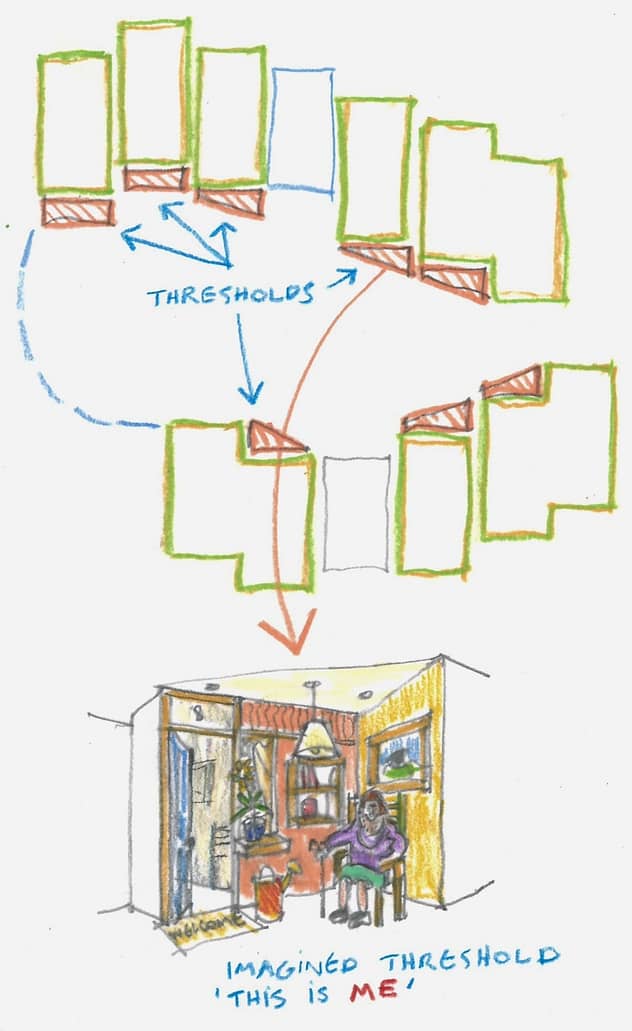

I can then head onward, independently, or with support. I don’t feel watched, or ‘looked after’ but rather I am clearly a part of real living community, a sort of collaborative family. We are all looking out for each other. It's clear to us that we are all at the heart of our group.
A Sense of Safety:
This is the springboard to positive, healthy, sustainable decisions and actions. Feeling safe provides the bedrock for positive action and, through the dignity it brings [12], improved resilience - our ability to positively bounce back in the face of difficulties. When people feel safer, they become less cautious [12]. It is composed of a mix of our sense of identity and the degree of lasting agency we have over our environment. Sense of safety involves our sense of being included - being part of a social group that plays a positive role in our lives. When we feel safe we are freely able to take actions in the world with the most positive long term wellness effect for ourselves and others. The more our ‘home’ is located within this context, the safer we feel and the more we can take on challenges or experience discomfort (take social risks) in order to grow and make progress.[13]
In addition, there are effects called peri-personal space and body schema. These describe how our brain takes ownership of objects and spaces that it has made intimate ties with, most usually through frequent use. They become ‘felt’ as a part of the body itself [14]. Interference with space and things included in the body schema creates a sense of pain or danger similar to if the body itself is interfered with or attacked [15] and social cues - the presence of others, and their behaviours - plays a large role in this [16]. So trust [13], that people entering your private space will do so only with your positive involvement, is crucial to building that sense of safety.
The Key Message for Staff:
Understand the importance of entering the customer’s home and bedroom. It is done with permission and their full involvement and agreement. Not out of ‘habit’, or social mores. The way you ask to enter a personal ‘home’ space, and how you behave, including facial expression, within that space will strongly impact sense of safety. This will impact long term positive decision making for the person whose space you have entered.
In addition, any interaction with things in that personal space must be with full positive involvement of the person/people who call that space home. This is not part of being polite - it is part of strengthening their sense of safety.
On this basis staff have an interesting idea to explore that they can strengthen and become skilled in, as opposed to a bland order such as always knock before you hurry in. When I am entering and in someone’s private room, my work is to increase their sense of safety and confidence. The role and the rough ‘how to’ is clear, it’s up to the team to explore the concept from there.
In Terms of the Built Environment:
An oversized room, for a person with reduced ability is less likely to support their sense of positive agency and safety, than a smaller space that they can properly manage and take ownership of.
So, a person wakes in their room, full of things that they have control over and that the care team respect and support them to control. They feel safe; the bedrock for confidence is there. A staff member knocks and enters and admires, takes interest in things and pictures, possessions and in the person, not just because it contributes to the sense of safety, but because of two key ingredients of each day:
Anchoring, Peak-End Rule:
‘Anchoring’ and ‘Peak-End Rule’ are cognitive bias [17]. It means that the first [18], the peak and last [19] experiences of something tints all the other experiences of that thing and it’s overall memory. A good ‘first thing’ in the morning experience will give higher value to all that comes later that day, and a good ‘last thing’ at night experience will make reflections on that day better. Setting the stage for a good day can be done and practiced in any number of creative ways. One nursing home in New York, for example, starts its customers’ days with a ‘good morning’ video in bed. It is of the person’s family or friends wishing them well and a good day to come.
Anchoring the waking and heading to bed experiences in positivity, as well as considering/capitalising the ‘peak’ experience of a day, is another idea that can be explored creatively by the staff team and those they support - it’s an opportunity to have fun - with a purpose.
Positive vs Negative Affect (mood):
This ties into positive and negative affect [20] - evidence from the field of positive psychology. It tells us that in order to function well, cognitively, we need at least 3 positively affective experiences for every 1 negative [21]. Ideally the ratio should be 11/12 positive experiences to every 1 negative (some positive challenge is needed). The fascinating result is that with this ratio in balance our ability to view life and problems in ‘the big picture’ and wider context increases. This boosts our ability to cope, to problem solve and perceive challenges and situations in a balanced manner. When we experience excessive negative mood states verses the ideal ratio - we become increasingly myopic. As we become increasingly narrow minded, our coping ability crashes, along with any hope of finding creative solutions. In this state we are stuck focusing on the problems. Therefore, when staff are aware of this, and with practice, they are able to understand that when they introduce positive mood, discuss engaging good things, point out objects, pictures and positive ideas, they can transform positive decision making and coping for the people they support. Suddenly there is purpose and result. Staff can become expert at this skill and be creative in applying it. This is not simply a social skill; it is crucially about considering the built environment. Is it creating opportunity for positive discussion, for items and pictures of interest to be present? Is it setting the stage for uplifting social interactions? Does the building and the spaces of which it comprises present a positive outlook AT ALL TIMES?

Wherever we go there are green views, natural light, and opportunities to get out doors. There are no dingy internalised ‘dead’ spaces to drag down staff or customers. Everything is uplifting.

With everything ‘to hand’ and diverse journeys throughout the shared space that offer a continual stream of different things to do, it’s easy to let go of worries about the past and future. Here we can let go of concerns about memory loss and dementia and any other troubles. This is because of how easy it is to live in and make the most of the very best of what’s possible in the present. This place makes us equals, and we all join in to make our home the kind of place that we love to live in and that helps us be our best selves regardless of abilities.
Living in the Present:
What is the power of focusing on what is possible ‘now’ [22]? This not only levels the playing field for people living with a dementia [23], but crucially it allows for the creation, invention and re-invention of new and positive senses of identity [24]. The most positive experiences are generated by doing, not by sitting ‘at leisure’ [25]. Doing can only be done in the present. We do not put focus on who someone used to be, but instead, by focusing on the present, we find the opportunity in it. The present is where we can be creative, have fun, experience emotion, joy and receive the benefits of wellbeing and positive mood. Everything is possible in the present, nothing need be abstracted. Abstraction is a source of anxiety, anxiety creates the symptoms of stress without any stressor present [26]. Anxiety is entirely counterproductive and unnecessary - there is no upside or easy solution like with many actual stressors.
By living in the present we are freed up to embrace the best of who we are now [24]. Staff can enjoy helping those they support to discover who that might be. What are their current abilities and interests and how do they click with the possibilities open to them in the here and now. Staff learn not to discuss the past or future unless this is something initiated by the person they are working with. For such an approach to work, it must be possible to see, to sense and engage with a choice of activities - i.e. for the staff to focus on the present, there must be a world of opportunity ALSO present.
A World of Opportunity:
The Maracuja Club built environment is carefully designed to directly act to support the staff. The bedrooms, the private spaces as discussed above, open onto a shared space. This space retains sense of safety because it is a logical progression from private personal space to semi private, shared, ‘family’ space - no sharp contrast from private to fully public. It is full of opportunity and choice, clearly visible from the threshold of the bedroom. It is shared not publicly, but rather it is a neighbourhood enjoyed together with a small number of dedicated staff and other residents. The built environment is a critical key to ensuring that the residents and staff remain focused on what is possible in the present. It is constantly possible, through choices and actions, made in the moment with no support, to positively re-identify yourself within the shared neighbourhood space. No past or future are necessary for a great day to be enjoyed.
At Maracuja Club, activities are not abstract ideas at the end of long corridors and around several confusing corners, or through receding doors. Activities are immediately present, in abundance!
Mental Models - a world and a self that make sense:
This considered approach to space making supports a person’s mental model of why they live and who they are, and what they do.
[27] “A mental model is an interrelated set of beliefs that shape how a person forms expectations for the future and understands the way the world works. Mental models can shape how an individual thinks about or understands how something or someone does, can, or should function in the world.”
Maracuja Club makes positive anchoring at wake up and bedtime easy. It makes increasing positive vs negative mood states easy. It makes tailored activity and objects that lift mood or make personal connection easy. The built environment forms a multi sensory illustration that guides the creation of a positive and engaging mental model, that is easy for customers and staff to grasp.
The staff can supply as much or little help as needed for people to move simply from their room to immediately available meaningful, bespoke activity and social engagement. Living in the present means we do away with judgment, accept people as they are, and engage with what they could do, and how they feel right now.
Sense of Identity:
Identity is the result of choices, actions and their outcomes. This leads to a revised relationship with the senses, with social groups, activities and the world at large as our perception of 'ourself-in-context' develops. Choices are made based on sensory cues. Staff can explore how to make those cues as appealing, positive and the activities they lead to, as rewarding as possible. Using the methods above, and more to come below, it is possible to build a stress-free, strong sense of identity, every day, for the people at Maracuja Club. In this way, the dependency-based role is shattered. People become honoured as individuals and as part of a close-knit supportive community. At no point so far is there anything that obstructs optimum engagement, inclusion, orientation, or introduces needless additional difficulties for someone living with a dementia. But also, no-one is singled out in any way. It is the picture of a model of care that everyone can enjoy, within a built environment that directly supports that care model and makes it easy to deliver.
[28] “identity is organized, is learned, and is dynamic… …The outcome could be either healthy and coherent identity formation or identity confusion… …Identity achievement is the status in which the individual has explored his or her identity potential fruitfully and can now commit to a particular identity… …Possible selves represent those elements of the self-concept that individuals could become, would like to become, or are afraid of becoming… …[a person is] less likely to engage in problem behavior when they have a sense of purpose and meaning in life.”
We know that positive self evaluation is energizing, while negative self evaluation disturbs emotions and reduces ability. Roles in life can only be discovered through the presence of opportunities and situations, these lead to experiences that create clarity of identity. Reducing self discrepancies in identity through safe positive social experiences and activities promotes positive self esteem. At Maracuja Club through staff modus operandi and built environment we make renewed positive identity formation easy - all the resources are immediately to hand.
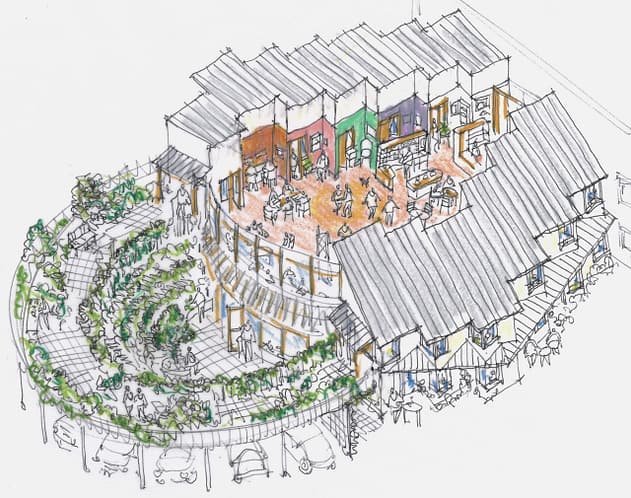
Somehow living here is uplifting, I don’t feel as stressed, distracted or lonely as I used to, it’s like I have got my focus back. Somehow the range of things to do each day and the way they are presented makes it so easy to join in, have a laugh without a worry in the world. I don’t think so much about the old me, why would I when here enjoying the current me is so easily possible. It’s as if there are a set of magic ingredients we live with here, supplied by the staff with such ease within this delightful space. People can arrive quite troubled but this place seems to be like medicine - it positively transforms people. It seems that the staff really love it, we do so often feel like one big happy family - in it together, for each other.
Wellbeing and What to do:
But what guide is there in providing and co-creating things and opportunities to do within the activity spaces that are the focus of Maracuja Club communities? Science tells us the answer in a UK government backed research study [7] . The findings have also been simplified for easy communication by the New Economics Foundation [6] . Using that and research from other sources we can define the proven causes of human wellbeing -
‘connect’
‘Take notice’
‘Keep learning’
‘Give’
‘Stay active’
These are the classical 5 ways to wellbeing.
But there is more a human needs:
High quality relaxation [29] [30]
Novelty [31]
Sensory needs [32]
Green views [33]
Natural light [34] [35] (and interior lighting [36])
Under these umbrellas it is possible to generate a programme of creative activity that uniquely honours the skills and interests of each small social group being supported and the staff that support them. This ensures that each day of every week, all year, everyone gets some of each of the proven causes of wellbeing. This is a fun and interesting challenge, that matures the idea of activity and the care role in nursing homes. It brings a much greater focus on the everyday and what can be done together, in a natural manner within each community cluster - for both enjoyment as well as the associated concrete health outcomes.
Sensory Needs:
Of special mention is sensory need. Aside from the other causes of wellbeing, sensory need sits slightly separately as a consideration. It emphasizes the importance of choices being available at all times, (as they are by the very nature of Maracuja Club architecture and the work of the staff). When there is a choice of places to be, activities to do, people to engage with, outdoors and indoors etc - it is possible to self-modulate one’s sensory experiences. So that, with minimal assistance you can meet your personal sensory needs. When sensory needs are met challenging behaviors reduce; mood, functional performance, attention to surroundings improve. [37] [32] [38]
The Spirit of Togetherness:
Interestingly, the most potent means of accessing the maximum causes of wellbeing at one time is through activities that have a social aspect - things you can do together.
But how should activities be made inclusive, and engaging? How should staff have the confidence to provide support in this?
Luckily it’s not hard, in fact, it’s very natural. Also, there is scientific study to help us.
‘Flow Theory’, ‘Relationship Theory’ and ‘Leadership Theory’ all help staff in creating (and co-creating) successful activities for and with the people they support. From the everyday folding of clothes, helping with food prep to anything as un/usual or exciting as you can think of.
Flow Theory:
Flow theory simply explains that for something to be engaging for a group of people, it needs to be accessible at varying levels of challenge and varying levels of skill. This means multiple participants can enjoy the same activity together without getting bored or frustrated. So, for a laundry task there might be sorting, folding, conversation, tea and drinks, ‘quality assurance’, maybe commentary on the fashion or patterns on the items; a wide range of people might be able to gather and enjoy it, as a social event. This also plays a role in reinforcing positive sense of identity. [39] [25]
In a creative activity it is easy to have different entry levels and difficulty levels, with elements part completed for those that need an easy access point – this can also be an opportunity to help each other - a proven cause of wellbeing, and a support to functional memory. [40]
[41] “Vernooij-dassen (2007) highlights that meaningful activities for persons with dementia are strikingly similar to those reported by anyone else. That is, ‘the activities of persons with dementia become meaningful through feelings of pleasure and involvement, a sense of connection and belonging, and a sense of autonomy and self-identity’”
Basic patterns for creating activity provision and encouragement come naturally:
-A discussion commences,
-A theme is introduced to the discussion that implies an activity
-Props/images/equipment/other may be introduced or found
-Staff/resident-leaders/enthusiasts begin to model the activity and different ways to begin it, from easy to more challenging
So, discussion blossoms into co-production of activity on a theme.
Leadership and Social Modelling:
This is where leadership and social modelling comes in.
We look at the leadership models used for vulnerable dependents [42] - since this is the situation. People in nursing care are vulnerable to the mindset of dependence, therefore much of the parent child scientific modeling is highly relevant. Consequently, the basis for an activity is thematic discussion - a group gathered around in which the idea of an action is introduced, discussed and begins. People find their place within that activity as they choose. It all takes place on the model of a warm nurturing attitude to each other, with independence, bi-directional communication, reasoning around issues, and freedom in approach to the activity [42].
The staff role is very much one of social modeling; their behaviors, their modus operandi demonstrates a positive, inclusive, fun approach to what is being done. The staff might also embrace some silliness, showing it is okay and acceptable to get things ‘wrong’, or to be unusual and in fact it’s part of the enjoyment and discovery. It is not about being the expert, it is about what the group can get out of it together. Just as every day ‘normal’ tasks are important, so are the more creative ones. Creative activity is inherently natural to human beings, it makes room for some of the most powerful freeing up of identity and expression of feelings, emotions, ideas. There is always room for everyone to fit in, find themselves and enjoy others.
[41] “people with mild to moderate dementia find their lives to be meaningful through doing”
All this may sound complex, but it is in fact easy to learn, and is extremely natural. It is exciting for staff, as they will find their own style, their own rhythm, the themes they are best at introducing and how to work well with the people they are supporting.
Getting Time Back:
You may wonder at this point; how can anyone have the time for all this? Well… it’s easy, once you remove the residential corridors, you don’t need to deal with navigation and A-to-B distances, that become multiplied with each separate individual, to get them involved in things. The things, the stuff of life – they’re right outside their doors! And it is ALWAYS present, it is not got out and put away for another week. For the most part, everything is out, and has its place. People living in that particular community cluster have at the ready, the things they generally like to do each week. (More specialised events and activities then are able to take place within the wider specialist spaces provided outside of the neighbourhood clusters).
Relationship/Attachment Theory:
Staff are also guided by relationship/attachment theory [43] [44] [45]. Which, for the most part is about predictability. The dependent person can predictably rely on you. This is the basis of good attachment, positive social behaviours and mood come with it. For this to function optimally, staff need to pay regular/predictable attention to each person. Arranging small community groups in clusters allows this to happen naturally. The resident should be able to see that help is coming as soon as the staff are free, not feel alone and abandoned, with no help in sight. The Maracuja Club built environment directly helps the staff deliver this type of experience. The community cluster of 11 rooms around the shared activity space does this. Wherever a person is they can be aware of where the staff and others are. They can appreciate when someone is busy, and see them coming, with anticipation, to help them.
Spatial Hierarchies:
Hierarchy of privacy and space typology is of critical importance in creating a logical, worry-free community. It makes orientation easy. It creates social, emotional and physical accessibility. It generates the basis for an inclusive culture on as equal a footing as possible, for all.
We all know the ideal of the family home setting, also anthropologically we see through human history a preference for living in clusters across cultures globally [46]. In particular when institutional/industrial influence remains low we see dwellings naturally ‘gathered’ around purposeful social spaces. Private rooms open onto semiprivate ‘family’ spaces. This shared ‘family’ type space then gives way to public space shared with a wider community that itself gives way to the wider world. The social transitions are clear, the privacy transitions are clear and familiar. This is key to building the confidence and sense of inclusion that is the basis for good, resilient, wellbeing. At Maracuja Club the bedroom opens onto a familiar space, with familiar faces and objects that hold meaning. The community cluster or ‘Neighbourhood’ has an entrance vestibule and ‘front door’ in which to build confidence, gather a group for an excursion or special activity and prepare oneself for the more public realm. Anyone can intuitively feel the power of this.
It is not about ‘doing to’, it is all about ‘doing with’ and being with. Celebrating one another, enjoying and sharing each other’s strengths. Creating opportunity to feel, act and be, in different ways, at different times, each day. Within Maracuja Club, from the moment of waking, a resident is presented with warmth, choices, and easy ways to get on with a rich mixture of activities with others. They can even choose not to, and within the open social setting, this too affirms who they are and how they feel. Whatever they do, or choose to do, or not do, they are increased by it, in wellness, ability, confidence and identity. Long term health is optimised.

Science tells us that when we transform the environment in which someone lives - (the physical infrastructure and the social interactions) - we can totally transform mental and physical health outcomes that in turn radically and positively transform behavior, experience of symptoms, sense of self worth, self acceptance, longevity, quality of life, ability and ability retention, and ever so much more.
Fundamental Attribution Error = enemy no. 1:
Before wondering if, really, any of this makes a difference to how people behave, their health, their wellness, and all the positive outcomes listed at the start of this article, consider ‘Fundamental Attribution Error’ [1], which results in the main critique aimed at Maracuja Club. It is a cognitive bias that encourages us to view each other as inherently ‘as we are’. “This person is just trouble” etc... Whereas Maracuja Club requires that we must remember the reality - the way we behave is much more the product of our social and physical environment - our behaviors are caused. We have to put in effort to fight the human bias to believe behaviors are inherent. They are not inherent - they are caused. We must follow the guidance that science outlines, to create an environment which gives each human being the maximum opportunity to flourish. This is what Maracuja Club is all about - it’s an endless tapas feast laid out, right under your nose, of all the known causes of wellbeing.

When we get a group of 11 or so people together, they tend to naturally form a few mini groups, or ‘cliques’, of about 3 to 5 people in each, which is ideal for conversation, bonding and sharing activities. [56] [57]
When we are part of a group, or can see groups around having a good time then, in the right setting and with the right support, it makes it feel safe and attractive to join in. We end up doing and getting involved more than we would have done otherwise - positive social activity is healthy - it's the richest and most diverse source of proven wellbeing assets.

Built Environment Specifics:
We have touched a little on how the building helps with all this, let’s now go into more detail.
We know that abstraction is bad. It absorbs cognitive function, turns stress into its even more damaging brother - anxiety and leads to unnecessary confusion.
From Pseudo Certainty to Boosting Motivation:
This also ties in with a bias called pseudo certainty effect [47]. If we are comfortable where we are, with good things around us, and we are told about an activity or event that is not present, our brain encourages us to remain where we are. Here at least a reasonably decent experience is certain. It takes much more effort and time to get someone to engage in things that are up a corridor, round a corner and through a door and down a lift, than it is to have them engage in something that is visible, within reach, and present. This is especially true when they can see others already enjoying themselves - a ‘bandwagon effect’ [48] is generated. Also, when there is a journey of positive opportunities, increasing in benefit on the way to the main attraction - hyperbolic discounting effect [49] - it becomes exponentially easy to get people motivated and involved.
By creating an architecture that opens bedrooms onto choices of increasing interest and benefit, that others are already engaged in - it is possible to make the experience of getting up and busy in world much much easier, quicker and mainly self-motivated.

The staff team, between activity leaders and carers, have a good grasp of the system for social support. It gives them confidence in delivering daily experiences that they know result in the health outcomes they witness each day for the people they work with. It is for the system of infrastructure to make this as easy as possible for the staff and residents to get on with and enjoy. We can map out and remove needless causes of stress from our design, so that only the most potent causes of wellbeing are present and as accessible as possible.
Learning from Neuropsychology:
There is simply no need for abstract stress. There is also no need for many direct stressors. Leading research in Neuropsychology [50] tells us that excessive high contrast decorations can be a needless drain on attention and cognition. The same is true for geometric patterns, parallel lines, patterns with excessively regular repeats. High contrast should be used sparingly, attracting attention to clear signals that contribute to understanding the purpose of the particular space/sub-space.
Highly decorative agitating wallpapers, that have become popular in nursing homes, are a stimulatory/distracting mask that a space is wearing to make it feel like something is going on there. When you look around, nearly always there is nothing much happening, and nothing much to do other than sit. We have to ask, why is wallpaper calling for attention? Why are we using up precious cognitive and mental capacity with the wallpaper? We badly need to conserve those cognitive reserves to maximise ability and mood!
Another related effect described by Neuropsychology is one of unusual movements, seen out of the corner of the eye. They call for attention and use up cognition in order for the brain to process them as safe. It can be enough, simply with a tv left on, to use up ALL the cognitive reserve of a person or group of people left in a room with a programme running that few, if anyone is wanting to watch [50]. TV is often effectively a prison – as with diminished cognitive reserves - a person has to keep an eye on it.
When we see so called ‘wall murals’ that are essentially wallpaper masquerading as a window, or bookcase, a pot of flowers and even a pub optics rail: this is a risk. We could have provided something real, instead we opted for a piece of artifice. When people approach and realise it does not feel like a book or plant or windowsill they can start to doubt their senses [50]. This leads to valuable cognitive reserves, in short supply, also being used up to worry about what they are seeing versus what reality actually is. Bumps and falls can increase due to this distracting sensory doubt. A needless reduction in available ability is brought about. Instead, with a little thought, provision of real physical things of use and interest will affirm the senses rather than bring them into doubt.
Wall to ceiling glass is not a good idea for care, as, in a similar way, it absorbs excessive cognitive reserves. Glass is not viewed as a barrier by the brain, we have to consciously form the idea of safety using working memory [50]. This means we are wasting the cognitive reserves of someone in care, that could be put toward rewarding and affirming activities.
When we choose to take up the mental capacity of a person in a care setting, we must realise that how we use that mental capacity is critical for their good health and ongoing retention of ability. Therefore let’s aim to remove all non-useful/non-productive stressors. The things we make engaging and interesting must have value in terms of the proven causes of wellbeing.
Colour, Tone and Orientation:
Colour is important, but not in the way we think. Colour does not contribute to easy navigation, nor explicitly to visibility. Tone and its contrasts imply lines, by means of these combined with scale over distance, we see perspective (3 dimensions). Objects seen against a mid-tone/darker wall can appear larger, as opposed to appearing smaller against a white wall. Colour does not contribute to perspective, orientation, or the 3d modelling of space in the brain.
What does colour do? It creates emotion, feelings, moods. Colour stimulates. It does this in the form of a journey, moving from one space to another, directing gaze from one colour to another. They stimulate, invigorate, or help to relax. And moreover, people are shown to change their minds about colours every 15 minutes or so as their own mood and thoughts change [51]. There is no need to worry about a ‘bad’ colour as such. The key is in the overall aesthetic and emotional journey the colours create. Colour introduces a free daily opportunity for people to feel, discuss, respond, build identity, make choices - which is important. A lack of feeling is the enemy of human life.
To orientate ourselves, science tells us that the brain is naturally formed to most easily use relative distance and relative direction [52] as opposed to object, colors and landmarks. It will differentiate directions based on their relative distance/pattern/scale. Therefore, these should be utilised as much as possible. Signs, words, colours can help, but these do require more advanced cognitive functions and learned skills. If we can use the modes most easy for the brain, that’s better for us all.

When you can get from thought to action, with minimal barriers, life is ever so much easier. When living with a dementia or other conditions that are requiring extra concentration and mental effort to cope with; it just makes common and scientific sense to create an infrastructure that reduces burdens on functional and long term memory, allowing for instant sensory choice.
We all know, from the carers' perspective too, any reduction in stress and cognitive load is a needed weight off the mind. When we combine a system for social care with an infrastructure that perfectly matches and supports it - the feeling and sense of reward a carer gets from their work can be magnified by many times over:
Wherever I am in the building, I am skilled and confident, I understand how what I do and the way I do it transforms wellness and health outcomes for the people I care for. When I see them flourish, I know how I and my colleagues did it - it’s rewarding work that I am extremely proud to be a part of.
I work creatively with the Maracuja Club System for social interaction to achieve the best results for the people I care for. I contribute to the body of knowledge about what works in what situations. I enjoy sharing and discussing best practice, as well as trying out other peoples’ ideas. The System gives us confidence, guidelines around which to be creative and measure the effectiveness of what we do and how we do it.
The way the building is here, makes all this so easy, and often fun. The experience of being a carer, compared to what it was, is now so much more easy, uplifting delightful.
A Note on Memory:
At Maracuja Club the choices are not so hard to remember [53]… Memory works best when [40] the same thing is presented in multiple formats - 'dual coding' - pictures & words for example. The choices on offer are visible from your bedroom door, and the staff can tell you about them. 'Concrete examples' again: you can see what is available for real, can see people doing them for real or at least demonstrating them if needed. ‘Elaboration’ comprises seeing and hearing all this so you can discuss your preferences and explore your own ideas about them. Similarly, with ‘Spaced Practice' and 'Interleaving’, each choice can be viewed separately and returned to in different orders. ‘Chunking’ is when you are able to visually break down everything on offer into a set of simple, clearly delineated ‘items’ to choose from or elements of a process to complete. All these are possible in Maracuja Club because of how the space will physically present itself to you. At Maracuja Club we go back to the root science and make life easy for you to get the absolute most out of it.
In Summary:
By utilizing the straightforward science of human wellbeing, sensory and cognitive function, we can reduce and prevent challenging behaviours, we can reduce signs and symptoms of dementia and depression, we can increase positive social behaviours, increase retention of ability, boost mood, boost immune function and make caregiving enjoyable, collaborative and skillful. When we follow the evidence, we make caregiving the uplifting celebration and cutting edge of ‘Being Well’, that it should be. Staff will feel expert, as leaders in their field. They will be creative about caregiving and rewarded by the great results and outcomes they see in the people they give care to. They will be aware of exactly how they brought those outcomes about.
Moreover, Maracuja Club staff will not be working in in 'double loaded corridors' [54] proven to increase stress, anti social behaviors and reduce positive social interaction. Instead, we provide the optimal environment for wellbeing: a shared space associated directly with a small cluster of bedrooms, bathed in natural light, green views, garden access on both floors, with interest, engagement and novel activities to do, every day. As well as enjoy specialist activity spaces shared with everyone and the local community at Maracuja Club.
The science is already there to do it differently. Come with us; let's stand on Tom Kitwood’s shoulders and use the science to change care in a way he would have thoroughly embraced.
It’s about time we began on the road to building the first step in a new, exciting and uplifting way of care giving.

We know that the old double loaded (bedrooms/doors along both sides) corridor, and to a lesser extent it’s single loaded brother, are not good for human health, social interaction, stress and positive behaviours [54]. - another good reason to take them out of the lives of our most vulnerable people and those supporting them. There’s just no need for them, especially when the alternative is so good.

The double barreled approach:
- a clear system for the social elements of care
- within a clear system for the infrastructure that supports it.
This shoots down needless troublemaking (indeed sick making) stress and introduces a feast of health boosting causes of wellbeing in its place.

It’s a community model that simply makes sense, scientifically as well as common sense.
It’s normal to be able move from your private space, to go looking for things to do, within a safe environment shared with just a small number of people.
It’s normal to go from there to more public and specialist activities outside of your home community, and it’s normal to go from there out to the wider world.
Maracuja Club makes social sense, it makes psychological sense, and it makes living your best life easy.
Care teams easily learn, with practice, to put the focus on the present moment.
They can learn to intuitively grasp the benefit of uplifting the mood, especially in the mornings.
They learn with ease to explore and affirm someone's choices, preferences, and the possibilities present for them today.
It becomes second nature to provide a range of ways to access any given activity. With a little thought anything can be made widely inclusive to a whole range of skills and ways of contributing.
It’s a small step for things to become about the enjoyment of doing them, setting judgment aside and placing the value on togetherness and discovery - it naturally feels great.
Validating contributions and finding meaning in actions and wishes is so obviously powerful.
It’s fun to have a structure like the proven causes of wellbeing providing the basis of themes to work with. They provide a creative adventure and a worthy challenge for each day and each week.
The team can bond and be inventive about achieving these goals. Suddenly care isn’t random any more - we know what we are doing and why - finally something concrete we can get together and work towards.
A clear system for the social side of caregiving and its real outcomes, combined with infrastructure that makes it easy is a no brainer.
We know that systems in healthcare are key to supporting the very best outcomes. [55]
Maracuja Club is a vital leap forward to defining the best systems for social and infrastructure in care for older people. We get the system right and it becomes easier to identify the right leaders to deliver those repeatable results across an entire network of social care provision. We can have the highest of expectation for the experience of social care provision and its outcomes.
Below, a montage, showing our team in the pilot project putting into effect, and putting their spin on, the then nascent system for social support we have developed.
Let’s get the first one built and proven. Complete funding is poised for release, and will be unlocked by partnership with an existing care organisation.
Therefore we welcome you to approach us regarding the forming of a joint venture - let's change the future of care together.
Roland McMorran BA Hons. Pst Grad Dip.
roland@maracujaclub.com

Although the model we have developed is highly evidence based, it helps to remember that the evidence is an expression of optimal - that is to say - natural, healthy human function. Therefore for the most part it serves to guide, affirm, and give weight to what comes naturally to people.
Here we can see the staff at the pilot project getting to grips with the proven causes of wellbeing, and the flow of the day. How to introduce themes, and how themes naturally become co-produced, socially rewarding activities.
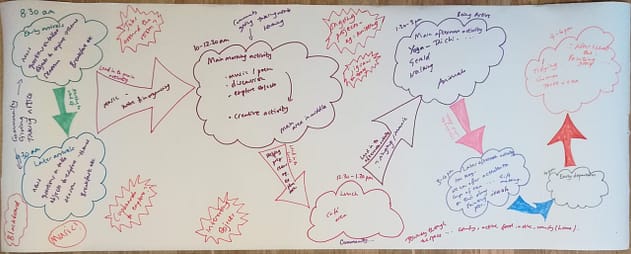
Looking in this case at the 'classic 5 ways to wellbeing', the team free think around these to come up with themes that could lead to maximum contact with the causes of wellbeing.

They expanded on the theme of Flowers. How it ties into learning, through history and opinions such as the 'Tulip Fever' exploding the price to purchase bulbs. Flowers also feature in poetry, people might give by sharing poems they discover about flowers, or by potting some bulbs for each other. Writing our own poems or making some art around the flower theme would support taking notice, maybe there's a walk in it - potting bulbs too would help to keep active. Exploring and discussing the meaning of flowers together, our thoughts and feelings about them and their role in our lives would, along with a cup of tea, provide some high quality connection alongside all the other possible activities.

Thinking in this way quickly becomes habit. Adding in the other supports and causes of wellbeing across a day, week and month likewise becomes familiar and easy.
Planning becomes fairly quick and spontaneous, especially as resources are gathered and created, and the staff build on growing knowledge of the people they are working and co-creating with.
It becomes easier and easier, as they are better practiced, to focus on the present - what is possible right now. To provide ramps of challenge and difficulty so an activity works inclusively for everyone becomes second nature. Adding in moments of novelty, becomes a source of fun. Modeling interest and positive social engagement, placing emphasis on the social pleasure of doing, rather than result, to support peoples confidence joining in, all become a daily norm.

Gathering resources along rough themes, can be an activity, social focus and rich seam of causes of wellbeing in itself. Plenty of options readily to hand is key, so that the team can go with the flow of the day. Having a plan is good, but it's even better if the plan can respond to the people you are working with - affirming interests, identity, choices - honoring the person and also the group identity too.

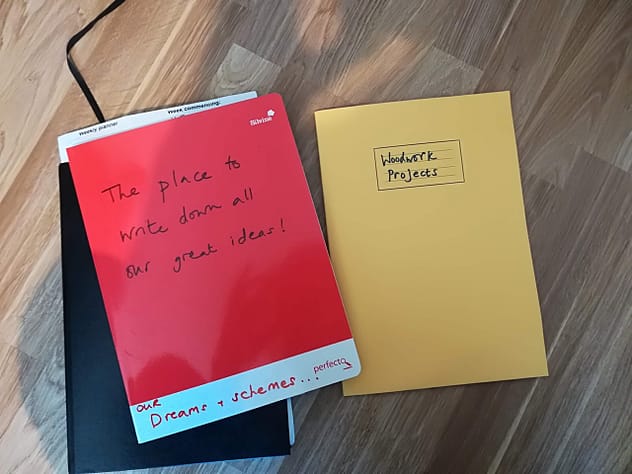


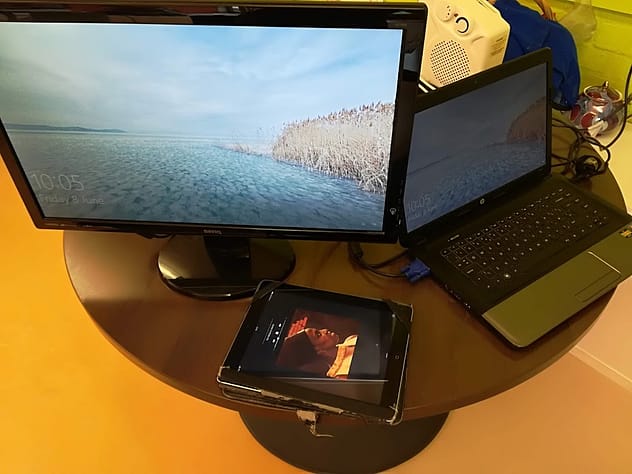


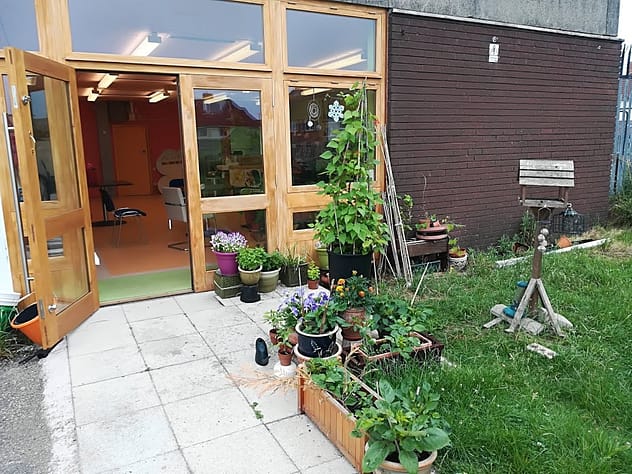
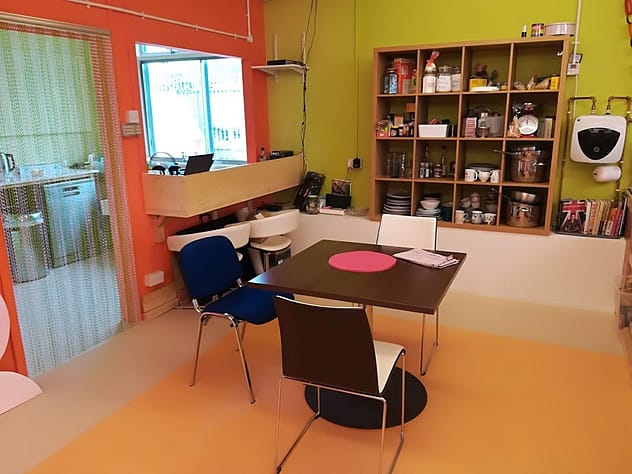
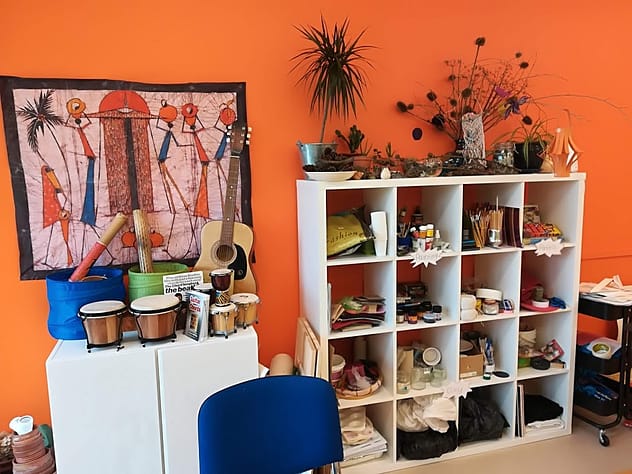
Here's an example of something the team was doing on birds -
identifying, discussing, creating stories and poems, learning interesting facts, watching nature footage. There's room there to focus in on one or two causes of wellbeing, and/or include them all...

With ancient arts as a starting point, almost any creation can be validated and discussed, however simple or complex the finished item may be.
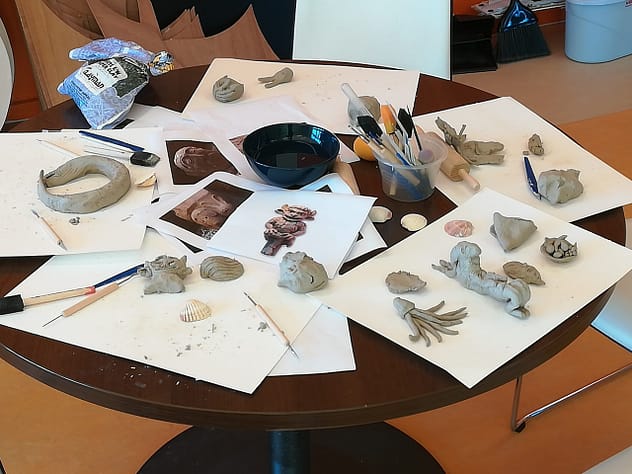
When you're focused on the quality of the experience rather than on what is being made, naturally humor arises and the social experience in enjoying it is ascendant.
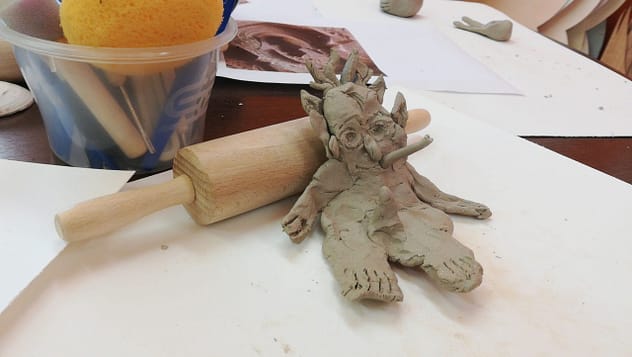
Sometimes it's as easy as gathering round an idea. What may look simple below is in fact carefully designed by the team to positively affirm identity, get people being creative about how they see themselves, express emotion, and build rich social connections.
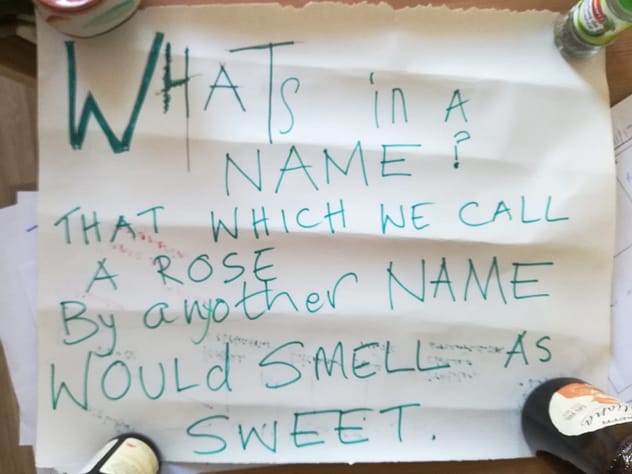
Concrete casting, done safely is a solid long term, practical and highly rewarding project. It involves connecting with others through team work, the 'giving' of support to each other and the finished product. The self affirmation of 'being able' to create something that has meaning and use. It might even go down as a novel experience, and a creative learning curve.
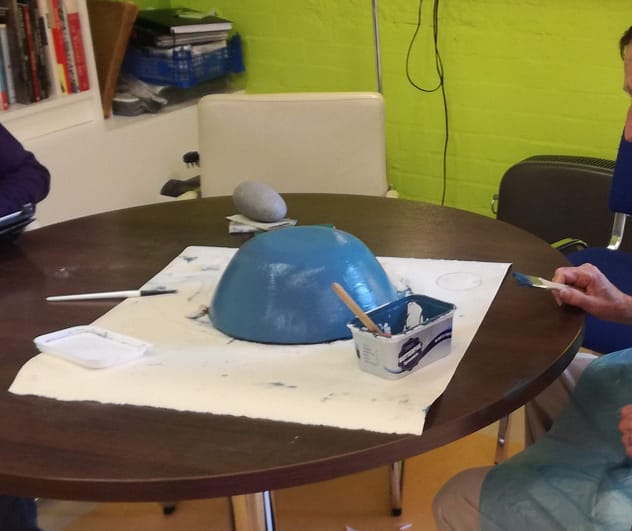
Can you spot it? ready for use!

From simple instructions to having a go. It's not about knowing best - it is about doing together.

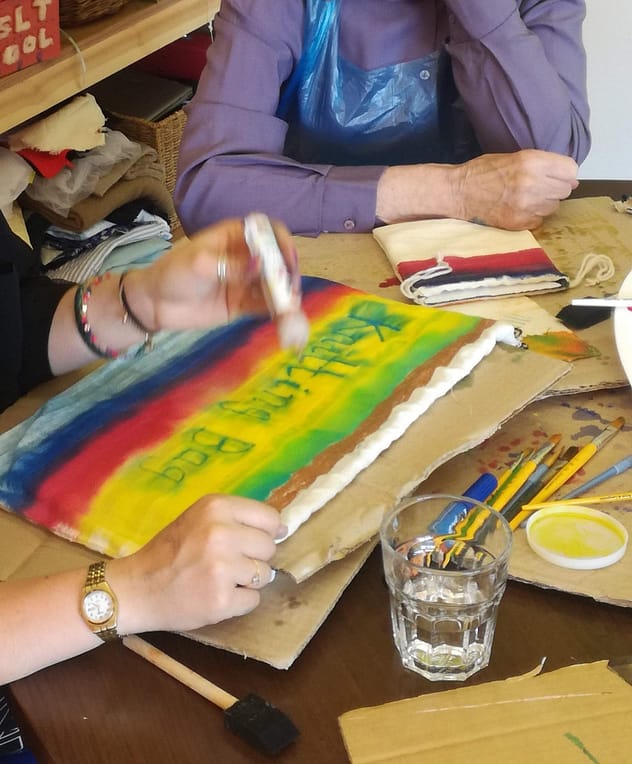
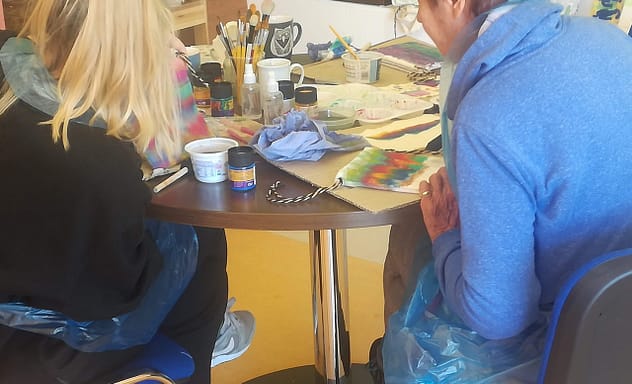
Meals and cooking are great and easy to make safe. Highly multi sensory, from scrubbing, cleaning, grating, tasting. They can keep you active, highly social, with rich resources to connect over, learn, give, and take notice - no wonder meals and cooking is historically at the center of so much of human society and culture - did I mention identity?.
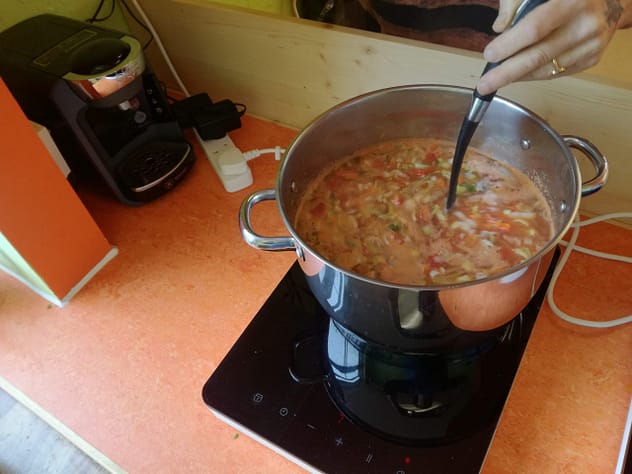
Another 'gatherer' to conversation, thinking, connection. Notice it stays in the present, although people may recollect or recall their past, there is no pressure for them to do so. They can decide, right now, what they feel the brightest moment of their day/s could be. The same is true for everything at Maracuja Club.

Exploring Morse Code - an un-planned exploration into one man's interest in the secret language of dots and dashes.
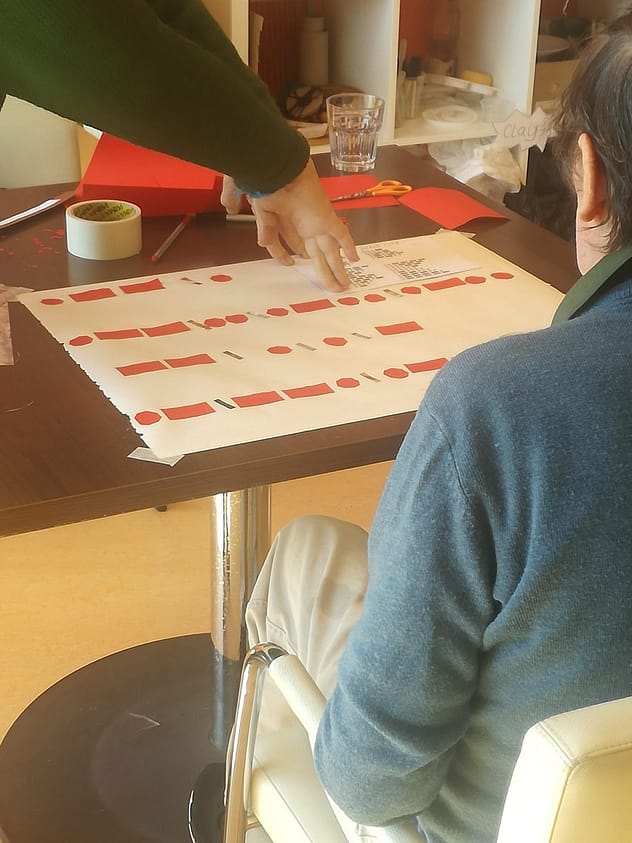
Another project, impromptu skittles this time. None of team had ever played skittles - so the experts took the lead, as they did on other occasions for dancing, and more.


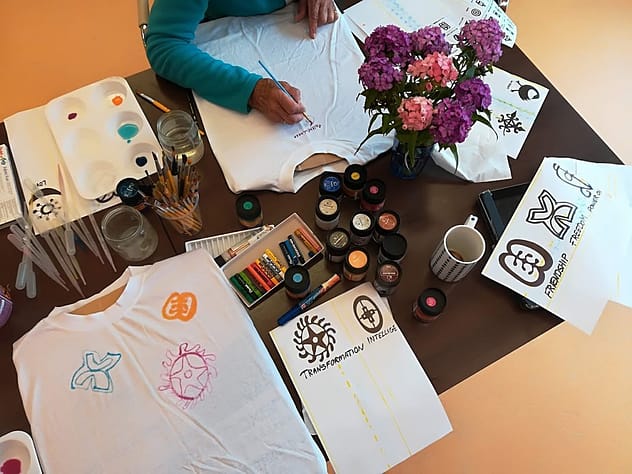

Using technology it's possible to instantly explore, affirm and turn ideas, interests and one off thoughts into wellness boosting opportunities and activities. Here, after an activity using West African symbols, it turned out someone used to speak Wolof, a West African language, widely spoken in Senegal, Mauritania, and the Gambia. One thing sparks another, and with the right resources to hand, they can be converted into rich seams of the causes of wellbeing.

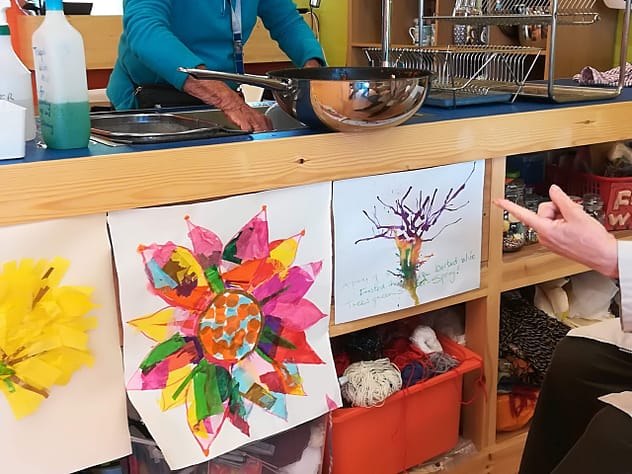

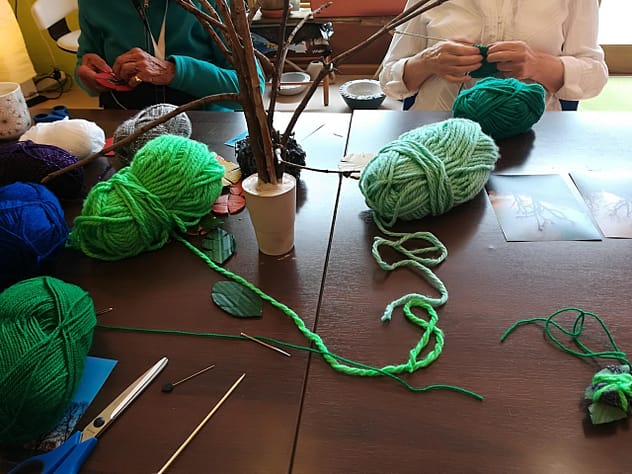




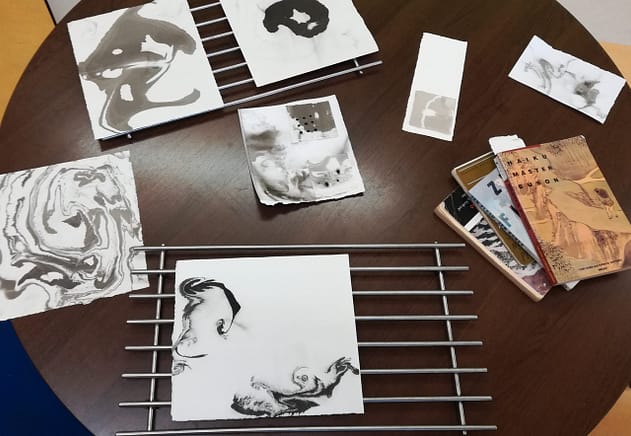
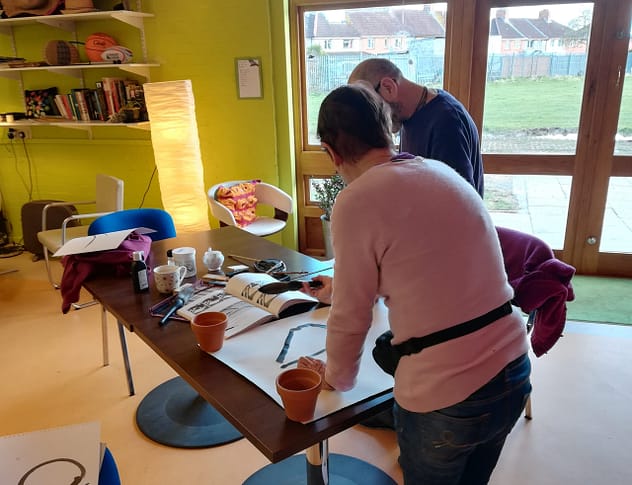
This project transformed people from depressed and closed to being leaders of activities, from home life being on the verge of impossible to sustainable good spirits, improved ability and reduced challenging behaviors. People moved from being inactive and little responsive, to engaged, fun, interesting and interested. The staff loved the challenge of using a clear system for enhancing health and boosting interaction. It was so rewarding for them, they didn't want the Pilot project to end.
Now it's time to change the wider narrative for residential and respite nursing and dementia care. We have the system, and we have the offer of funding. We just need a care organisation to join us. This will unlock the funding for a 66 bed nursing home with respite centre, and on success of the 1st home there is strong interest in funding for a further 5.
To take this project forward as a Joint Venture, get in touch with us at roland@maracujaclub.com
1. McLeod, S.A., Oct, 31). Fundamental attribution error. Simply Psychology. Attribution Theory 2018 2018; fundamental attribution error]. Available from: https://www.simplypsychology.org/fundamental-attribution.html.
2. Team, H.I.A., THE RELATIONSHIP BETWEEN WELLBEING AND HEALTH. 2014, Department of Health.
3. Magyar-Moe, J., Therapist's Guide to Positive Psychological Interventions. 2009: AP.
4. Droes, R.M., et al., Effect of the Meeting Centres Support Program on informal carers of people with dementia: results from a multi-centre study. Aging Ment Health, 2006. 10(2): p. 112-24.
5. Droes, R.M., Meeting Centres Support Programme UK: Overview, evidence and getting started. 2017, University of Worcester.
6. Foundation, N.E., Five Ways to Wellbeing New applications, new ways of thinking. 2011, NEF.
7. The Government Office for Science, L., Foresight Mental Capital and Wellbeing Project, in Foresight. 2008.
8. Buedo-Guirado, C., Rubio, L. , Dumitrache, C. G. , and Romero-Coronado, J., Active Aging Program in Nursing Homes: Effects on Psychological Well-being and Life Satisfaction. Psychosocial Intervention, 2020. 29(1): p. 49-57.
9. Droes, R.M., et al., Effect of combined support for people with dementia and carers versus regular day care on behaviour and mood of persons with dementia: results from a multi-centre implementation study. Int J Geriatr Psychiatry, 2004. 19(7): p. 673-84.
10. McMorran, W., The Architecture of Care. 2017, Winston Churchill Memorial Trust: Winston Churchill Memorial Trust.
11. Kitwood, T., Dementia Reconsidered, the person comes first. Rethinking Ageing, ed. B. Gearing. 1997: Open University Press.
12. al., S.M.S.e., Resilience definitions, theory, and challenges: interdisciplinary perspectives. European Journal of Psychotraumatology, 2014. 5.
13. Snow, S., How Psychological Safety Actually Works, in Forbes Magazine. 2020, Forbes.
14. Holmes, N.P. and C. Spence, The body schema and the multisensory representation(s) of peripersonal space. Cogn Process, 2004. 5(2): p. 94-105.
15. Bufacchi, R.I., G., An Action Field Theory of Peripersonal Space, in Trends in Cognitive Sciences. 2018, Cell Press Reviews. p. 1076.
16. Bogdanova, O., The Peripersonal Space in a social world. Cortex, Elsevier, 2021. 142.
17. Cherry, K., What Is Cognitive Bias?, in Very Well Mind, L. Amy Morin, Editor. 2020, Very Well Mind: https://www.verywellmind.com/what-is-a-cognitive-bias-2794963.
18. Staff, P. The Anchoring Effect and How it Can Impact Your Negotiation. Negotiation 2019 Nov 26, 219; Available from: https://www.pon.harvard.edu/daily/negotiation-skills-daily/the-drawbacks-of-goals/#:~:text=2019%20%2F%20Negotiation%20Skills-,The%20anchoring%20effect%20is%20a%20cognitive%20bias%20that%20describes%20the,information%20to%20make%20subsequent%20judgments.
19. Doll, K. What Is Peak-End Rule? Theory & 14 Real-Life Examples. Body and Brain 2019 September 10, 2022; Available from: https://positivepsychology.com/what-is-peak-end-theory/#research.
20. Denollet, J. and J. De Vries, Positive and negative affect within the realm of depression, stress and fatigue: the two-factor distress model of the Global Mood Scale (GMS). J Affect Disord, 2006. 91(2-3): p. 171-80.
21. Manfred Diehl, E.L.H., and Kathleen M. Berg, The Ratio between Positive and Negative Affect and Flourishing Mental Health across Adulthood. Aging Ment Health, 2011.
22. Seikkula, J., Becoming Dialogical: Psychotherapy or a Way of Life? THE AUSTRALIAN AND NEW ZEALAND JOURNAL OF FAMILY THERAPY, 2011. 32(3): p. 179-193.
23. Carewatch. Using Mindfulness With Dementia. 2017; Available from: https://www.carewatch.co.uk/using-mindfulness-with-dementia/#:~:text=Living%20moment%20to%20moment&text=With%20dementia,%20Mindfulness%20helps%20the,relaxation%20technique%20and%20a%20distraction.
24. Warchol, C.w.K. Living With Dementia Means Living in The Moment. Dementia Care 2022 January 31, 2022; Available from: https://www.crisisprevention.com/Blog/living-with-dementia-means-living-in-the-moment#:~:text=When%20we%20consider%20those%20living,supports%20to%20make%20it%20happen?%E2%80%9D.
25. Csikszentmihalyi, M. and J. LeFevre, Optimal experience in work and leisure. J Pers Soc Psychol, 1989. 56(5): p. 815-22.
26. Association, A.P. What’s the difference between stress and anxiety? October 28, 2019 February 14, 2022; Available from: https://www.apa.org/topics/stress/anxiety-difference.
27. Holtrop JS, S.L., Matlock DD, Glasgow RE and Green LA, The Importance of Mental Models in Implementation Science. Frontiers, 2021.
28. Tsang, S.K.M., Positive Identity as a Positive Youth Development Construct: A Conceptual Review. Scientific World Journal, 2012.
29. Schrempf, M.C., A randomised pilot trial of virtual reality‑based relaxation
for enhancement of perioperative
well‑being, mood and quality of life. Nature, 2022. 12.
30. L.Baird, C., Effect of guided imagery with relaxation on health-related quality of life in older women with osteoarthritis. 2006.
31. Bardi, K.E.B.A., Acts of Kindness and Acts of Novelty Affect Life Satisfaction. The Journal of Social Psychology, 2010. 150(3): p. 235-237.
32. Collier, L. and A. Jakob, The Multisensory Environment (MSE) in Dementia Care: Examining Its Role and Quality From a User Perspective. HERD, 2017. 10(5): p. 39-51.
33. Soga, M., A room with a green view: the importance of nearby nature for mental health during the COVID-19 pandemic. Ecological Applications, 2020.
34. Boubekri, M., Impact of Windows and Daylight Exposure on Overall Health and Sleep Quality of Office Workers: A Case-Control Pilot Study. J Clin Sleep Med, 2014.
35. Osibona, O., Lighting in the Home and Health: A Systematic Review. Environment Research and Public Health, 2021.
36. Sinoo, M.M., Lighting Conditions in the Nursing Home. Gerontechnology, 2012.
37. Collier, L., et al., Multisensory stimulation to improve functional performance in moderate to severe dementia--interim results. Am J Alzheimers Dis Other Demen, 2010. 25(8): p. 698-703.
38. Collier, A.J.L., How to make a Sensory Room for people living with dementia. 2015: Kingston University London.
39. Mao, Y., Optimal Experience and Optimal Identity: A Multinational Study of the Associations Between Flow and Social Identity. Front Psychol, 2016.
40. Pomerance, L., Learning About Learning. 2016, National Council on Teacher Quality.
41. Beard, R.L., Art Therapies and Dementia Care: A Systematic Review. Dementia, 2012. 11: p. 633-656.
42. Parenting, W., Authoritarian Vs. Authoritative Parenting – An Insight, in https://wowparenting.com/blog/authoritarian-vs-authoriatative/. 2019.
43. Fleming, T., A Secure Base for Adult Learning: Attachment Theory and Adult Education. The Irish Journal of Adult and Community Education, 2008.
44. Perren, S., et al., The impact of attachment on dementia-related problem behavior and spousal caregivers' well-being. Attach Hum Dev, 2007. 9(2): p. 163-78.
45. Nelis, S.M., L. Clare, and C.J. Whitaker, Attachment representations in people with dementia and their carers: implications for well-being within the dyad. Aging Ment Health, 2012. 16(7): p. 845-54.
46. Duly, C., The Houses of Mankind. 1979: Thames and Hedson.
47. Blawatt, K.R., Marconomics - Appendix A - List of Cognitive Biases. 2016.
48. Niesiobędzka, M., An experimental study of the bandwagon effect in conspicuous consumption. Current Issues in Personality Psychology, 2015. 6(1).
49. Lab, T.D. Why do we value immediate rewards more than long-term rewards? 2018; Available from: https://thedecisionlab.com/biases/hyperbolic-discounting/#:~:text=Hyperbolic%20discounting%20can%20result%20in,incentivizes%20impulsivity%20and%20immediate%20gratification.&text=Decisions%20that%20prioritize%20short%2Dterm,long%2Dterm%20well%2Dbeing.
50. Leonards, P.U., Interview regarding Neuro-Psychology and optimal human function, R.F.A. McMorran, Editor. 2019.
51. Ruth Brent Tofle, P.D.B.S., Ph.D So-Yeon Yoon, MA. Andrea Max-Royale, M.E.Des., Color In Healthcare Environments - A Research Report. 2004, Coalition for Health Environments Research.
52. Ayzenberg, V., The relations among navigation, object analysis, and magnitude perception in children: Evidence for a network of Euclidean geometry. Cognitive Development, 2020. 56.
53. Smith, M. Six Strategies for Effective Learning. 2022; Available from: https://www.learningscientists.org/blog/2016/8/18-1.
54. Epstein, M., Crowding Stress and Human Behaviour. Journal of Social Issues, 1981. 37.
55. Gawande, A. (2014). The Century of The System. The Reith Lectures. BBC. Radio 4, BBC.
56. Dunbar, R. I. M. (1994). "SIZE AND STRUCTURE OF FREELY FORMING
CONVERSATIONAL GROUPS " Human Nature 6.
57. Gurteen, D. "Conversational Leadership." from https://conversational-leadership.net/optimal-group-size/#:~:text=Far%20too%20often%20in%20small,is%20the%20optimal%20group%20size.
